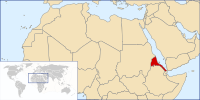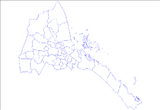Portal:Eritrea
The Eritrea Portal
Eritrea (/ˌɛrɪˈtriːə/ ⓘ ERR-ih-TREE-ə or /-ˈtreɪ-/ -TRAY-; Tigrinya: ኤርትራ, romanized: Ertra, pronounced [ʔer(ɨ)trä] ⓘ), officially the State of Eritrea, is a country in the Horn of Africa region of Eastern Africa, with its capital and largest city at Asmara. It is bordered by Ethiopia in the south, Sudan in the west, and Djibouti in the southeast. The northeastern and eastern parts of Eritrea have an extensive coastline along the Red Sea. The nation has a total area of approximately 117,600 km2 (45,406 sq mi), and includes the Dahlak Archipelago and several of the Hanish Islands. Human remains found in Eritrea have been dated to 1 million years old and anthropological research indicates that the area may contain significant records related to the evolution of humans. The Kingdom of Aksum, covering much of modern-day Eritrea and northern Ethiopia, was established during the first or second century AD. It adopted Christianity around the middle of the fourth century. Beginning in the 12th century, the Ethiopian Zagwe and Solomonid dynasties held sway to a fluctuating extent over the entire plateau and the Red Sea coast. Eritrea's central highlands, known as Mereb Melash ("Beyond the Mereb"), were the northern frontier region of the Ethiopian kingdoms and were ruled by a governor titled the Bahr Negash ("lord of the sea"). In the 16th century, the Ottomans conquered the Eritrean coastline. Beginning in 1882–1885, Italian troops systematically spread out from Massawa toward the highland, eventually resulting in the formation of the colony of Italian Eritrea in 1889. After World War II, Eritrea was administered by the British Military Administration until 1952. Following the UN General Assembly decision in 1952, Eritrea would govern itself with a local Eritrean parliament, but for foreign affairs and defense, it would enter into a federal status with Ethiopia for ten years. However, in 1962, the government of Ethiopia annulled the Eritrean parliament and formally annexed Eritrea. The Eritrean secessionist movement organised the Eritrean Liberation Front in 1961 and fought the Eritrean War of Independence until Eritrea gained de facto independence in 1991. Eritrea gained de jure independence in 1993 after an independence referendum. Eritrea is one of the least developed countries. It is a unitary one-party presidential republic in which national legislative and presidential elections have never been held. Isaias Afwerki has served as president since its official independence in 1993. According to Human Rights Watch, the Eritrean government's human rights record is among the worst in the world. The Eritrean government has dismissed these allegations as politically motivated. Freedom of the press in Eritrea is extremely limited; the Press Freedom Index consistently ranks it as one of the least free countries. As of 2022 Reporters Without Borders considers the country to be among those with the least press freedom. Eritrea is a member of the African Union, the United Nations, and the Intergovernmental Authority on Development, and is an observer state in the Arab League alongside Brazil and Venezuela. (Full article...) Selected article -The Eritrean War of Independence was a war for independence which Eritrean independence fighters waged against successive Ethiopian governments from 1 September 1961 to 24 May 1991. Eritrea was an Italian colony from the 1880s until the defeat of the Italians by the Allies of World War II in 1941, Eritrea then briefly became a British protectorate until 1951. The General Assembly of the United Nations held a meeting about the fate of Eritrea, in which the majority of the delegates voted for the federation of Eritrea with Ethiopia (UN Gen. Assembly UN Resolution 390 A), and Eritrea became a constituent state of the Federation of Ethiopia and Eritrea in 1952. The Federation was supposed to last for ten years in which Eritreans could have mini sovereign decisions such as a parliament and some autonomy, but under the Ethiopian crown for further ones. The Assembly also assigned commissioner Anzio Mattienzo to supervise the process. Eritreans were supposed to claim Eritrea as an independent sovereign state after the ten years of federation. However, Eritrea's declining autonomy and growing discontent with Ethiopian rule caused an independence movement led by the Eritrean Liberation Front (ELF) in 1961. Hamid Idris Awate officially began the Eritrean armed struggle for independence on 1 September 1961 on the mountain of Adal, near the town of Agordat in south western Eritrea. Ethiopia annexed Eritrea the next year. (Full article...)Selected picture -Did you know -
CategoriesRelated portalsWikiProjectsTopics in EritreaSelected panorama -Associated WikimediaThe following Wikimedia Foundation sister projects provide more on this subject:
SourcesDiscover Wikipedia using portals | |||||














































